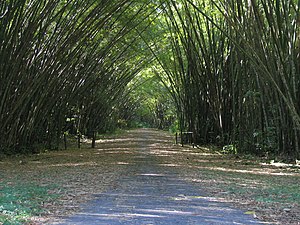 Image via WikipediaBy David M Guion
Image via WikipediaBy David M GuionYou can build houses, bridges, furniture, and fishing poles from bamboo. You can make clothing, towels, and rugs from it. You can even eat its shoots. What other product is that versatile?
It grows incredibly fast with little or no need for pesticides, fertilizer, or even irrigation. Harvesting it does not kill it, so the soil has no chance to run off. It is an ideal crop for restoring wetlands and other water and land reclamation projects. What could be more sustainable?
The more products we can make from bamboo in place of, say, wood or cotton - not to mention plastic - the greener we can become. And although bamboo has many associations with China and other Asian cultures, it grows well right here in the US. We don't have to import it.
Consider the products that can be made from it. The ancient Chinese invented gunpowder, and used bamboo to make firearms. They made suspension bridges by fastening bamboo rods together. They used bamboo fiber for making paper. Various Asian peoples crafted numerous kinds of flutes and other musical instruments from bamboo. Bamboo has been used to construct houses and other buildings not only in Asia, but throughout Central and South America.
More recently, laminates from bamboo can be used for all the same products as wood laminate. Bamboo cabinetry, furniture, flooring, kitchen counters, etc. can look like bamboo, or it can look like at least three different colors of hardwood. Bamboo is better than wood for some uses. For example, because it is antimicrobial, bamboo salad bowls, kitchen tools, and especially cutting boards will not harbor germs that can cause food-borne illnesses.
Fabric from bamboo is a still more recent development. At the molecular level, bamboo is very smooth. Therefore bamboo fabric is especially soft, making it an excellent choice for clothing, sheets, and towels. At the same time, bamboo fabric retains the toughness that makes it so suitable for bridges and construction scaffolding. Therefore, not only will it not wear out as quickly as other fabrics might, it is also quite suitable for making rugs. It is water and mildew resistant, making it especially appropriate for outdoor rugs and furniture.
Bamboo grows from a rhizome underground. The visible part above the surface, called the culm, grows to its full height and girth in a single growing season and is mature enough to harvest in three years. When a culm is cut down, the rhizome simply sends up a new one in its place. A tree, on the other hand, takes 40 years to grow to a suitable size. Cutting it down kills it. Irresponsible cutting, or even deforestation through various natural disasters, results in deforestation, soil erosion, and pollution of streams. Bamboo even delivers more oxygen than a similar-sized stand of trees.
Compared to cotton, bamboo yields about ten times more usable fiber per acre. And while bamboo requires little or no human intervention to thrive, cotton requires extensive irrigation and applications of pesticides and (usually petroleum-based) fertilizers. Bamboo, therefore, is not only versatile, but as a crop, significantly greener than two other renewable resources. This article is based on a much longer blog post, Versatile, sustainable bamboo.
David M. Guion
Eco-Friendly Home Products, part of the All-Purpose Guru family. Products for your entire home and everybody who lives there.
Article Source: http://EzineArticles.com/?expert=David_M_Guion
http://EzineArticles.com/?Bamboo:-Versatile,-Sustainable,-Green&id=6305981

No comments:
Post a Comment